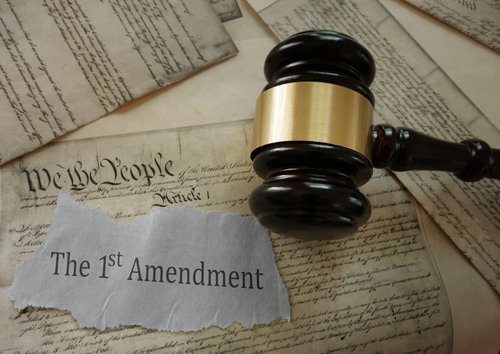In California, false light is a form of invasion of privacy for which you can pursue a civil claim. A false light claim exists when an individual or business
- publishes offensive information about you, and
- implies that it is true,
- when it is actually false.
A few common examples of false light include:
- A company publishes a picture of a married couple with a message stating that their only interest in one another is sex.
- John posts on his Facebook newsfeed a false claim that his ex-girlfriend Tyra has filed for bankruptcy.
- A business runs an advertisement that gives the false impression that Michael supports one of its products.
In California, you typically have a one-year statute of limitations, from the date of publication, to file a claim for false light.
The damages you may recover in these actions will ordinarily depend on the specific facts of a case. Some of the more common examples of damages, however, include compensation for:
- Harm to reputation, shame and hurt feelings;
- Damage to your trade or occupation; or,
- Loss of business income resulting from the disclosure.
To help you better understand the claim for false light, our California personal injury lawyers discuss the following:
- 1. Who can sue?
- 2. Elements of a Claim
- 3. Defenses
- 4. Damages
- 5. Statute of Limitations
- 6. Free Speech Defense
- 7. Related Causes of Action
- Additional Reading
1. Who can sue?
Only people, and not corporations or other businesses or social organizations, may sue in California on a claim for invasion of privacy.1
Also, only living people may file a false light invasion of privacy claim because a person cannot invade the privacy of a dead person.
Thus, an estate cannot sue for false light on behalf of someone deceased.2 This is unless the false light occurred before the person in question died.3
2. Elements of a Claim
California Civil Jury Instruction (CACI) 1802 spells out the elements of a false light claim. For you to win a lawsuit, you must prove by a preponderance of the evidence the following five elements:
- The defendant publicly disclosed information or material that showed you in a false light;
- The false light created by the disclosure would be highly offensive to a reasonable person in your position;
- There is clear and convincing evidence that the defendant knew the disclosure would create a false impression about you or acted with reckless disregard for the truth OR the defendant was negligent in determining the truth of the information or whether a false impression would be created by its disclosure;
- You were harmed OR You sustained harm to your property, business, profession, or occupation; and
- The defendant’s conduct was a substantial factor in causing your harm.4
In some cases, you might also have to prove that the defendant acted with actual malice.5
What is a public disclosure?
A false light claim requires public disclosure, or publicity.6 This means that information or a message must be given to the public.
California courts, however, have not given clear directions on how many people in the public must receive information for there to be a public disclosure.
- In one California court case, a public disclosure was found when a letter was published to 1,000 randomly selected men.7
- In another California case, there was no public disclosure when the defendant published information within a country club’s newsletter.8
Given these two cases, the determination as to whether information amounts to public disclosure will depend on the specific facts of a case.

A false light claim requires public disclosure, or publicity.
What is the definition of a false light?
The facts of a case will determine whether a public disclosure places you in a false light.
Some general rules help California courts determine if a false light was created. These are:
- At a minimum, you must show that the defendant’s disclosure implied something false9; and,
- A false light is created when your name is used in connection with a book, article, or idea with which you in fact are not associated.10
Examples of successful false light claims were given at the beginning of this article. Two examples of cases in which the court did not find a false light include:
- Tim wrote letters to people that suggested Carol had been fired from her job. There was no false light here since Carol did not want the firing to be a secret.11
- A T.V. station made statements about a public official that were not false.12
What is offensive to an average person?
California courts are not exactly clear as to what is considered offensive in false light claims.
Some courts have stated that this element is met when the false light is so offensive as to shock a community’s notion of decency.13
Other courts, however, have announced a slightly lower standard. In these cases, a false light only has to be offensive to a reasonable person.14
When must I show malice?
False light claims in California are sometimes like defamation claims in terms of the facts involved. In these situations, courts require you to show that a defendant acted with malice.15
Malice is shown when a defendant either:
- discloses information that they knew was false or
- discloses information and did not care if it was false or not.16

There are six common defenses raised in false light lawsuits.
3. Defenses
There are six common defenses raised in false light lawsuits in California. These are:
- You cannot support all the elements of the claim.
- The average person would not think there was offensiveness in the false light.
- Public disclosure was true and contained no false information about you.
- Public disclosure was an opinion and not a false fact.
- The defendant disclosed statements that were based upon information within public documents.
- The First Amendment protected the disclosure.
4. Damages
In general, you may be awarded three types of damages if you win a false light action in California. These include:
- General damages, which are damages for your loss of reputation, shame, and shame;
- Special damages, which are damages to your property, trade, occupation, or business income; or,
- Exemplary (punitive) damages, which are damages awarded at the discretion of the court or the jury, to be recovered in addition to general and special damages, and to be awarded for the sake of example and by way of punishing a defendant.
5. Statute of Limitations
In California, a lawsuit for false light invasion of privacy must be commenced within one year.
The one-year period (the “limitations period” or “statute of limitations”) starts running when you know – or, in the exercise of reasonable diligence, should have known – about the defendant’s wrongful actions.

The United States Supreme Court, in a long line of cases, has placed limitations on certain speech and expressions.
6. Free Speech Defense
A claim for false light in California appears to restrict a person’s right to free speech. Granted, while we enjoy this right, it is not absolute.
The United States Supreme Court, in a long line of cases, has placed limitations on certain speech and expressions.
7. Related Causes of Action
Defamation
Defamation cases in California consist of false statements that harm your reputation. If the statements are verbal they are called “slander.” If made in writing, they are known as “libel.”
Whether you can successfully sue under California’s defamation laws often depends on whether you are a public figure, a business or a private citizen. Private citizens have greater protection from defamation than people who are in the public eye.
In either case, however, the elements of defamation involve:
- An untrue statement,
- That was damaging to your reputation,
- Made to someone other than you (“published”),
- With knowledge of the statement’s falsity or failure to use reasonable care to ascertain its truth
If you are a private figure, you must prove malice to recover punitive damages for a matter of public concern. For further discussion, see our page on distinguishing defamation from false light.
Public Disclosure of Private Facts
Under California law, a “public disclosure of private fact” occurs when a person publicly discloses private and embarrassing facts about you that are not a legitimate public concern.
In particular, there are five elements to support a claim for public disclosure of private facts. These are:
- There is a public disclosure;
- That concerns private facts;
- The disclosure is one that would offend the average person;
- The disclosure was not of legitimate public concern; and,
- The defendant published private facts with reckless disregard for their truth or falsity.17
Business Disparagement
California law makes people liable for making derogatory statements about a business to discourage others from dealing with it. This tort is known as
- “commercial disparagement” or
- “business disparagement,” or
- “trade libel.”
Although similar to California’s law on defamation, the law on business disparagement exists to protect the financial reputation of a business (as opposed to your personal reputation). While it exists primarily to prevent unfair competition between businesses, it can also be brought against a customer.
The three claims mentioned above – defamation, public disclosure of private fact, and business disparagement – represent examples of a lawsuit where you sue for harm to your reputation.
Criminal Invasion of Privacy
Penal Code 647(j) PC is California’s criminal “invasion of privacy” law. PC 647(j) makes it a misdemeanor to violate your privacy in any of three specific ways:
- Using a device such as a telescope or binoculars to invade your privacy;
- Secretly photographing or recording your body under or through your clothing for the purpose of sexual arousal or gratification; or
- Secretly recording or photographing you in a private room in order to view your body or undergarments
Violating PC 647(j) is charged as a misdemeanor. A misdemeanor is punishable by:
- Up to six (6) months in county jail, and/or
- A fine of up to $1,000.18
Additional Reading
For more in-depth information, refer to the following scholarly articles:
- When Even the Truth isn’t Good Enough: Judicial Inconsistency in False Light Cases Threatens Free Speech – First Amendment Law Review.
- Invasion of Privacy: False Light Offers False Hope – Loyola Entertainment Law Review.
- Ethical Complexities in Defamation and False Light Claims – Georgetown Journal of Law & Public Policy.
- Twilight: The Fading of False Light Invasion of Privacy – N.Y.U. Annual Survey of American Law.
- Restraining False Light: Constitutional and Common Law Limits on a Troublesome Tort – Federal Communications Law Journal.
Legal References
- James v. Screen Gems , Inc. 174 Cal. App. 2d 650; Restatement 2d of Torts § 652E).
- See same.
- See same; see also Playgirl, Inc. v. Solano (9th Cir. 2002) 292 F.3d 1078.
- Gill v. Curtis Publishing Co. (1952) 38 Cal. 2d 273.; see also Time, Inc. v. Hill (1967) 385 U.S. 374, 387-388. California Civil Jury Instruction (CACI) 1802 (2024 edition).
- Selleck v. Globe Int’l, Inc. (Court of Appeals of California, Second District, Division Seven, 1985) 166 Cal. App. 3d 1123.
- Werner v. Times-Mirror Co. (Court of Appeals of California, Second District, Division Three, 1961) 193 Cal. App. 2d 111.
- Kerby v. Hal Roach Studios, Inc. (Court of Appeal of California, Second District, Division Three, 1942) 53 Cal. App. 2d 207.
- Warfield v. Peninsula Golf & Country Club (Court of Appeal of California, First District, Division One, 1989) 214 Cal. App. 3d 646.
- See note 4.
- O’Hilderbrandt v. Columbia Broad, Sys. Inc. (Court of Appeal of California, Second District, Division Three, 1974) 40 Cal. App. 3d 323.
- Patton v. Royal Indus, Inc. (California Court of Appeals. Second Dist., Div. Three, 1968) 263 Cal. App. 2d 760.
- Aisenson v. Am. Broad. Co. (Court of Appeals of California, Second District, Division Five., 1990) 220 Cal. App. 3d 146.
- O’Hilderbrandt v. Columbia Broad, Sys. Inc. (Court of Appeal of California, Second District, Division Three, 1974) 43 Cal. App. 3d 880.
- Wolston v. Reader’s Digest Ass’n (1979) 443 U.S. 157.
- Shulman v. Group W. Prods, Inc. (1989) 18 Cal.4th 200. See also Briscoe v. Reader’s Digest Ass’n (1971) 4 Cal. 3d 529, overruled on other grounds by Gates v. Discovery Communications, Inc. (Cal. 2004) 101 P.3d 552.
- Penal Code 647(j). See also Penal Code 19: “Except in cases where a different punishment is prescribed by any law of this state, every offense declared to be a misdemeanor is punishable by imprisonment in the county jail not exceeding six months, or by fine not exceeding one thousand dollars ($1,000), or by both.”
